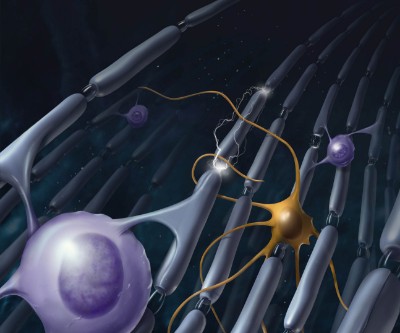
Oligodendrocytes (purple) myelinating axons. The gold cell is an astrocyte.
Credit: NIH Medical Arts
The brain must synchronize signals that can come from multiple areas in order to function properly, similar to how stoplights coordinate traffic flow on congested city streets. “Neurons that fire together wire together,” is a common phrase in neuroscience. It means that connections are strengthened when neural impulses arrive at the same time at key areas called synapses. However, signals from neurons that are further away from a synapse would need more time to arrive.
Scientists have proposed various models for how this coordination is achieved. One concept, called myelin plasticity 
Researchers at NICHD and the National Institute of Mental Health published a model on how this might work. They propose that oligodendrocytes play an active role by modulating the “spikes” of signals as they travel through neurons, in essence regulating the timing of brain communications. Physically, oligodendrocytes are poised for such as role, as they have approximately 50 projections that can simultaneously wrap around 50 individual neurons.
Through mathematical modeling and simulations, the team showed that oligodendrocytes can synchronize selective groups of axons that carry correlated spikes, not just all axons in a given area. Their model reinforces the myelin plasticity theory, showing that myelin can act as a lens to focus multiple signals that come into a specific brain region.
Overall, research in this area can bolster our understanding of neuronal processes, which can impact research on learning, memory, and behavior, as well as clinical work on neurodegenerative diseases.
Learn more about the Maternal-Fetal Medicine & Translational Imaging Affinity Group: https://www.nichd.nih.gov/about/org/dir/affinity-groups/MFMTI
 BACK TO TOP
BACK TO TOP